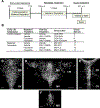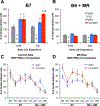Evidence for intact 5-HT1A receptor-mediated feedback inhibition following sustained antidepressant treatment in a rat model of depression
- PMID: 30170082
- PMCID: PMC6170686
- DOI: 10.1016/j.neuropharm.2018.08.032
Evidence for intact 5-HT1A receptor-mediated feedback inhibition following sustained antidepressant treatment in a rat model of depression
Abstract
Serotonin (5-HT) neurons are strongly implicated in mood disorders such as depression and are importantly regulated by feedback inhibition mediated by 5-HT1A receptors. These receptors may play a role, albeit a poorly understood one, in the generation of mood disorders, treatment response to antidepressants and delayed therapeutic efficacy. Here we sought to gain insight into the role of 5-HT1A receptor-mediated feedback inhibition in these processes by studying Fos protein expression within serotonin neurons in a rat model of stress-related mood disorder, early life maternal separation (MS), combined with two-week treatment with the antidepressant fluoxetine (FLX) in adulthood. We gauged 5-HT1A receptor-mediated feedback inhibition by the ability of the antagonist, WAY-100635 (WAY), to disinhibit Fos expression in 5-HT neurons. We found that two-week FLX treatment dramatically inhibited Fos expression in serotonin neurons and that this effect was reversed by blocking 5-HT1A receptors with WAY. Together these observations reveal that after prolonged exposure to SSRIs, endogenous 5-HT1A receptors continue to exert feedback inhibition of serotonin neurons. Furthermore we found unique effects of pharmacological treatments after MS in that the WAY effect was greatest in MS rats treated with FLX, a phenomenon selective to the rostral 2/3 of the dorsal raphe nucleus (B7). These results indicate that the balance between activation and feedback inhibition of serotonin neurons in B7 is altered and uniquely sensitive to FLX after early-life stress.
Keywords: Fluoxetine; Fluoxetine hydrochloride (PubChem CID: 62857); Fos; Raphe; Serotonin; Stress; Swim; WAY-100635 (PubChem CID: 5684).
Copyright © 2018. Published by Elsevier Ltd.
Figures




References
-
- Amat J, Baratta MV, Paul E, Bland ST, Watkins LR, Maier SF (2005) Medial prefrontal cortex determines how stressor controllability affects behavior and dorsal raphe nucleus. Nature Neuroscience 8(3): 365–71. - PubMed
-
- Arborelius L, Nomikos GG, Grillner P, Hertel P, Hook BB, Hacksell U, Svensson TH (1995) 5-HT1A receptor antagonists increase the activity of serotonergic cells in the dorsal raphe nucleus in rats treated acutely or chronically with citalopram. Naunyn-Schmiedeberg’s Arch Pharmacol. 352: 157–65. - PubMed
Publication types
MeSH terms
Substances
Grants and funding
LinkOut - more resources
Full Text Sources
Other Literature Sources

